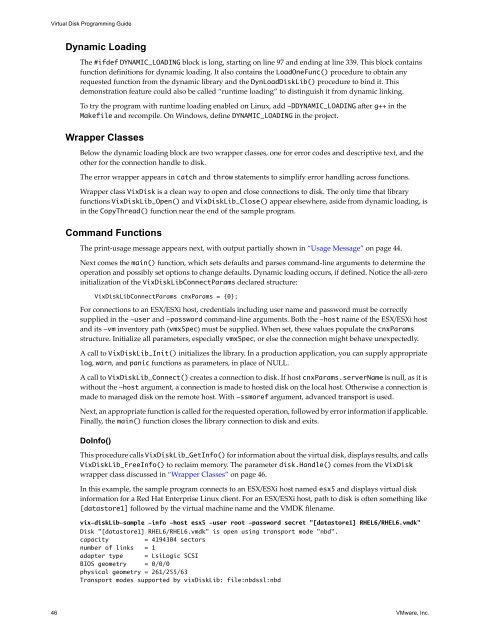Virtual Disk API Programming Guide - Documentation - VMware
Virtual Disk API Programming Guide - Documentation - VMware
Virtual Disk API Programming Guide - Documentation - VMware
You also want an ePaper? Increase the reach of your titles
YUMPU automatically turns print PDFs into web optimized ePapers that Google loves.
<strong>Virtual</strong> <strong>Disk</strong> <strong>Programming</strong> <strong>Guide</strong><br />
Dynamic Loading<br />
The #ifdef DYNAMIC_LOADING block is long, starting on line 97 and ending at line 339. This block contains<br />
function definitions for dynamic loading. It also contains the LoadOneFunc() procedure to obtain any<br />
requested function from the dynamic library and the DynLoad<strong>Disk</strong>Lib() procedure to bind it. This<br />
demonstration feature could also be called “runtime loading” to distinguish it from dynamic linking.<br />
To try the program with runtime loading enabled on Linux, add -DDYNAMIC_LOADING after g++ in the<br />
Makefile and recompile. On Windows, define DYNAMIC_LOADING in the project.<br />
Wrapper Classes<br />
Below the dynamic loading block are two wrapper classes, one for error codes and descriptive text, and the<br />
other for the connection handle to disk.<br />
The error wrapper appears in catch and throw statements to simplify error handling across functions.<br />
Wrapper class Vix<strong>Disk</strong> is a clean way to open and close connections to disk. The only time that library<br />
functions Vix<strong>Disk</strong>Lib_Open() and Vix<strong>Disk</strong>Lib_Close() appear elsewhere, aside from dynamic loading, is<br />
in the CopyThread() function near the end of the sample program.<br />
Command Functions<br />
The print‐usage message appears next, with output partially shown in “Usage Message” on page 44.<br />
Next comes the main() function, which sets defaults and parses command‐line arguments to determine the<br />
operation and possibly set options to change defaults. Dynamic loading occurs, if defined. Notice the all‐zero<br />
initialization of the Vix<strong>Disk</strong>LibConnectParams declared structure:<br />
Vix<strong>Disk</strong>LibConnectParams cnxParams = {0};<br />
For connections to an ESX/ESXi host, credentials including user name and password must be correctly<br />
supplied in the -user and -password command‐line arguments. Both the -host name of the ESX/ESXi host<br />
and its -vm inventory path (vmxSpec) must be supplied. When set, these values populate the cnxParams<br />
structure. Initialize all parameters, especially vmxSpec, or else the connection might behave unexpectedly.<br />
A call to Vix<strong>Disk</strong>Lib_Init() initializes the library. In a production application, you can supply appropriate<br />
log, warn, and panic functions as parameters, in place of NULL.<br />
A call to Vix<strong>Disk</strong>Lib_Connect() creates a connection to disk. If host cnxParams.serverName is null, as it is<br />
without the -host argument, a connection is made to hosted disk on the local host. Otherwise a connection is<br />
made to managed disk on the remote host. With -ssmoref argument, advanced transport is used.<br />
Next, an appropriate function is called for the requested operation, followed by error information if applicable.<br />
Finally, the main() function closes the library connection to disk and exits.<br />
DoInfo()<br />
This procedure calls Vix<strong>Disk</strong>Lib_GetInfo() for information about the virtual disk, displays results, and calls<br />
Vix<strong>Disk</strong>Lib_FreeInfo() to reclaim memory. The parameter disk.Handle() comes from the Vix<strong>Disk</strong><br />
wrapper class discussed in “Wrapper Classes” on page 46.<br />
In this example, the sample program connects to an ESX/ESXi host named esx5 and displays virtual disk<br />
information for a Red Hat Enterprise Linux client. For an ESX/ESXi host, path to disk is often something like<br />
[datastore1] followed by the virtual machine name and the VMDK filename.<br />
vix-diskLib-sample -info -host esx5 -user root -password secret "[datastore1] RHEL6/RHEL6.vmdk"<br />
<strong>Disk</strong> "[datastore1] RHEL6/RHEL6.vmdk" is open using transport mode "nbd".<br />
capacity = 4194304 sectors<br />
number of links = 1<br />
adapter type = LsiLogic SCSI<br />
BIOS geometry = 0/0/0<br />
physical geometry = 261/255/63<br />
Transport modes supported by vix<strong>Disk</strong>Lib: file:nbdssl:nbd<br />
46 <strong>VMware</strong>, Inc.

















